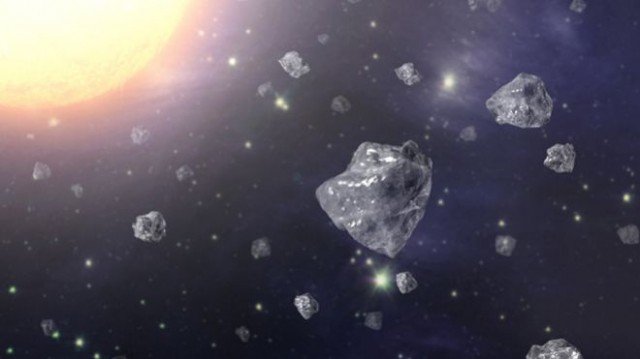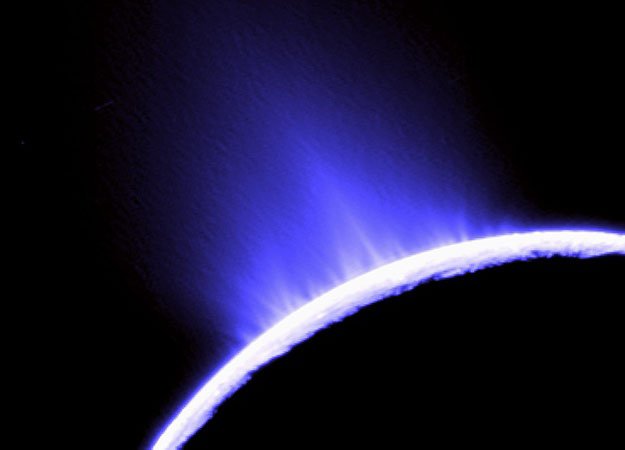Home Tags Posts tagged with "Saturn"
Saturn
According to US scientists, diamonds big enough to be worn by Hollywood film stars could be raining down on Saturn and Jupiter.
New atmospheric data for the gas giants indicates that carbon is abundant in its dazzling crystal form, they say.
Lightning storms turn methane into soot (carbon) which as it falls hardens into chunks of graphite and then diamond.
These diamond “hail stones” eventually melt into a liquid sea in the planets’ hot cores, they told a conference.
The biggest diamonds would likely be about a centimetre in diameter – “big enough to put on a ring, although of course they would be uncut,” says Dr. Kevin Baines, of the University of Wisconsin-Madison and NASA’s Jet Propulsion Laboratory.
Kevin Baines added they would be of a size that the late film actress Elizabeth Taylor would have been “proud to wear”.
“The bottom line is that 1,000 tonnes of diamonds a year are being created on Saturn.
“People ask me – how can you really tell? Because there’s no way you can go and observe it.

Diamonds big enough to be worn by Hollywood film stars could be raining down on Saturn and Jupiter
“It all boils down to the chemistry. And we think we’re pretty certain.”
Kevin Baines presented his unpublished findings at the annual meeting of the Division for Planetary Sciences of the American Astronomical Society in Denver, Colorado, alongside his co-author Mona Delitsky, from California Speciality Engineering.
Uranus and Neptune have long been thought to harbor gemstones. But Saturn and Jupiter were not thought to have suitable atmospheres.
Kevin Baines and Mona Delitsky analyzed the latest temperature and pressure predictions for the planets’ interiors, as well as new data on how carbon behaves in different conditions.
They concluded that stable crystals of diamond will “hail down over a huge region” of Saturn in particular.
“It all begins in the upper atmosphere, in the thunderstorm alleys, where lightning turns methane into soot,” said Kevin Baines.
“As the soot falls, the pressure on it increases. And after about 1,000 miles it turns to graphite – the sheet-like form of carbon you find in pencils.”
By a depth of 6,000km, these chunks of falling graphite toughen into diamonds – strong and unreactive.
These continue to fall for another 30,000km – “about two-and-a-half Earth-spans” says Kevin Baines.
“Once you get down to those extreme depths, the pressure and temperature is so hellish, there’s no way the diamonds could remain solid.
“It’s very uncertain what happens to carbon down there.”
One possibility is that a “sea” of liquid carbon could form.
“Diamonds aren’t forever on Saturn and Jupiter. But they are on Uranus and Neptune, which are colder at their cores,” says Kevin Baines.
[youtube zQGiuQQD6ec]
It is well known that Earth is unique as the only planet in the solar system which can sustain life.
However, in other respects, Earth may not be quite as unusually as is often thought.
Astronomers studying Titan, Saturn’s largest moon, have described it as “a weirdly Earth-like place” when it comes to geology.
Titan boasts landscapes shaped by the flow of rivers – though they are rivers of liquid methane, not of water.
And, like Earth, the surface of Titan is surprisingly free of craters, implying that geological activity is constantly reshaping the moon, as also happens here.
The icy landscape of Titan was first discovered by Earth-bound researchers in 2004, when the Cassini-Huygens spacecraft which orbits Saturn first broke through the moon’s atmosphere.

Astronomers studying Titan, Saturn's largest moon, have described it as "a weirdly Earth-like place" when it comes to geology
Scientists had previously been unable to see the amazing rivers which carve out channels in the moon’s surface, as its atmosphere is so thick with methane and nitrogen that the landscape is not visible from Earth.
Intrigued by the discovery of the methane rivers, researchers from MIT and the University of Tennessee at Knoxville wanted to investigate the history of Titan’s geology.
However, despite the visible river networks, the astronomers found less erosion than they had expected, given that Titan has been orbiting Saturn for four billion years.
Similarly, when they looked for craters which could have been caused by meteorites, there were far fewer than on most other moons in the solar system.
In fact, the number of craters was more reminiscent to the situation on Earth, where plate tectonics and volcanic explosions have covered up much of the impact of foreign bodies on the planet.
“Earth’s continents are always eroding or being covered with sediment,” said Taylor Perron, assistant professor of geology at MIT.
“That may be the case on Titan, too.”
Discovering which factors were responsible for shaping Titan’s landscape could be a challenge, as the satellite images do not give a good impression of the ups and downs of the moon’s terrain.
“It’s almost like we were thrown back a few centuries, before there were many topographic maps, and we only had maps showing where the rivers are,” Taylor Perron added.
Despite the challenges, Taylor Perron said he expected the similarities between Titan and Earth would give scientists an ongoing insight into how the moon’s surface has changed over millennia.
“It’s a weirdly Earth-like place, even with this exotic combination of materials and temperatures.
“And so you can still say something definitive about the erosion. It’s the same physics.”
NASA’s Cassini probe will make today its lowest pass yet over the south pole of Enceladus, an active moon of Saturn which may harbor a liquid water ocean.
The flyby, at an altitude of 74 km (46 miles), will allow Cassini to “taste” the jets of ice and water vapor that gush from the moon’s polar region.
Several lines of evidence suggest these jets are fed by a liquid water ocean beneath Enceladus’ outer icy shell.
The probe’s closest approach will take place at 19:30 GMT on Tuesday.
The scientists will use Cassini’s Ion and Neutral Mass Spectrometer instrument to learn more about the composition, density and variability of the plumes from Enceladus.
Scientists previously detected salts in these jets, which suggested the sub-surface liquid water ocean was probably in contact with Enceladus’ rocky core.
This makes Enceladus an even more important target in the search for life elsewhere in the Solar System, as rocks could furnish the ocean with the chemical ingredients thought essential for life.

Cassini probe will make today its lowest pass yet over the south pole of Enceladus, an active moon of Saturn which may harbor a liquid water ocean
The plumes erupt from fissures at the south pole known as “tiger stripes”.
Last week, scientists presented evidence of a connection between the jet activity on Enceladus and the way Saturn’s gravity stretches and stresses the fissures.
The results were outlined by Terry Hurford, from NASA’s Jet Propulsion Laboratory (JPL), at the Lunar and Planetary Science Conference (LPSC) in The Woodlands, Texas.
However, about 35% of the observations could not be explained by tension in the jets’ source regions.
Enceladus moves around Saturn in a distorted, oval-shaped orbit rather than a circular one. This causes the moon to be pulled and squeezed by Saturn’s gravity, inducing the heat that enables geological activity on the icy moon.
Cassini’s closest approach to any part of Enceladus occurred in October 2008, when it flew within about 25 km (16 miles) of the surface.
A flyby in October 2015 will bring Cassini about 25 km closer to the moon.



